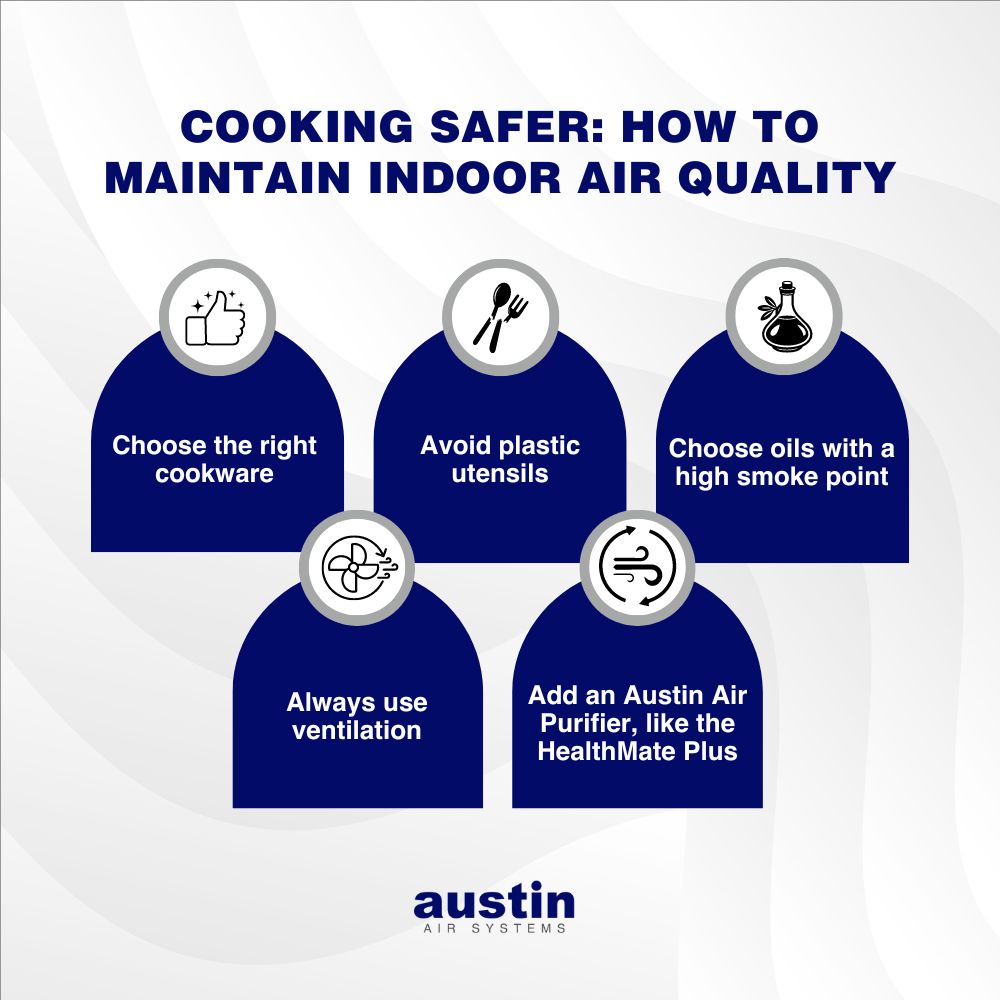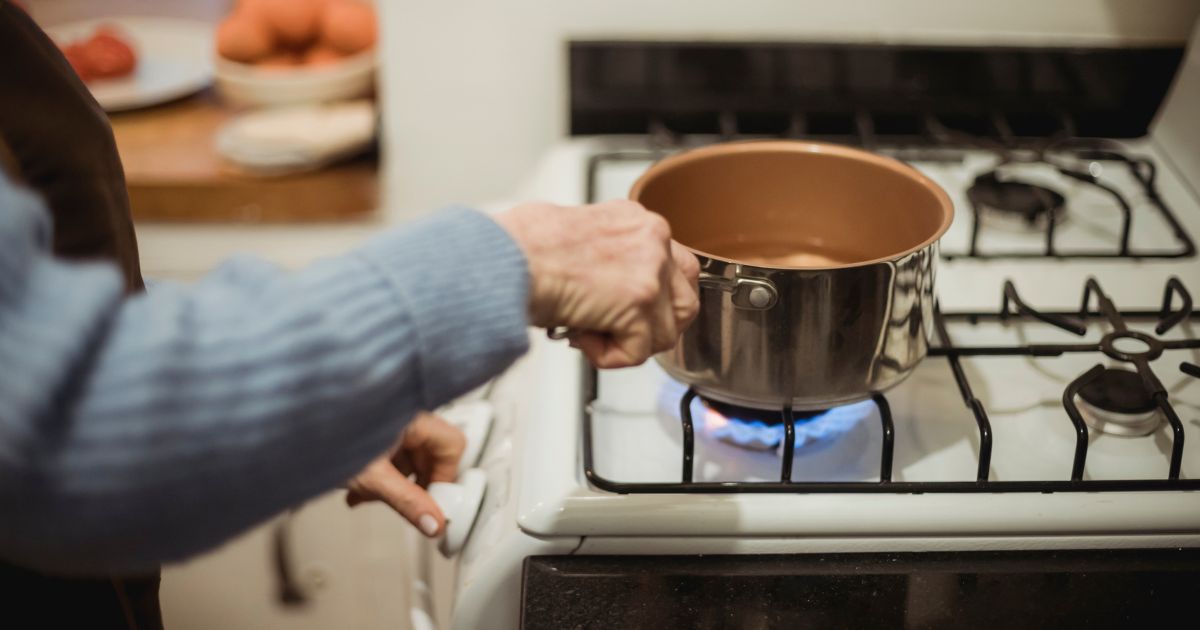Cooking is an essential activity in every household, but it also comes with hidden risks to indoor air quality. From fumes released by gas appliances to the harmful particles produced when food is burned, knowing what’s in the air you breathe while cooking can help you make safer, healthier choices and prevent long term exposure to toxins.
Let’s break down the pollutants that fill your kitchen and how you can improve your indoor air quality while preparing meals.
Pollutants Emitted While Cooking
Many people are unaware of the number of pollutants that cooking can release into the air. The culprits include:
Particulate Matter (PM): PM is a mix of tiny solid particles and liquid droplets in the air. Cooking processes like frying or grilling can release high levels of PM, which causes a range of health issues, from irritating the lungs to exacerbating respiratory conditions such as asthma to causing cancer.12
Nitrogen Dioxide (NO2): Especially prevalent with gas stoves, NO2 is a toxic gas that can reduce lung function and increase the risk of respiratory infections in children and adults.3
Carbon Monoxide (CO): Another gas commonly released from gas stoves, carbon monoxide can cause headaches, dizziness, and even death if present in high concentrations. CO is a major reason why you should never use propane stoves inside without a carbon monoxide detector.4
Volatile Organic Compounds (VOCs): These harmful chemicals are emitted from cooking oils and heated fats. They can contribute to indoor air pollution and are associated with respiratory and cardiovascular problems.5
Acrolein: Acrolein forms from burning tobacco, wood, gasoline, and paraffin. But it also comes from burning plastics (like utensils) and overheated fats or oils (including vegetable oil). It is an eye and lung irritant.6
Formaldehyde: Formaldehyde, a known carcinogen, can be released during cooking, especially when using gas stoves or burning food at high temperatures. It’s also emitted from certain cooking oils when overheated and from charred foods.7
Polycyclic aromatic hydrocarbons (PAHs): PAHs form when food, particularly meat, is cooked at high temperatures, like grilling, frying, or charring. The smoke and fumes released during these high-heat methods can carry PAHs into the air.8
The Problem with Gas Appliances
Many cooks prefer gas stoves because the temperature is easier to control than electric stoves. Unfortunately, gas stoves and ovens are a major contributor to indoor air pollution. In exchange for precise temperature control and fast heat, chefs experience the release of harmful pollutants like NO2 and CO directly into your kitchen. Without proper ventilation, these pollutants can build up quickly, turning your home’s air toxic.
What Happens When We Burn Food?
Burning food releases harmful compounds into the air, including particulate matter and carcinogens like formaldehyde and polycyclic aromatic hydrocarbons (PAHs). The smoke can linger in your home and settle on surfaces, causing long-term exposure to harmful chemicals. This is why it’s crucial to avoid burning food and ensure proper ventilation while cooking.
Cooking Safer: How to Maintain Indoor Air Quality
Now that we’ve identified the common pollutants, let’s look at practical steps to cook safely and keep your home’s air clean:
- Choose the Right Cookware: Avoid cheap, non-stick cookware that may release harmful chemicals when overheated. Instead, opt for stainless steel, cast iron, or ceramic cookware, which are safer options that don’t emit toxic fumes.
- Use the Right Cooking Utensils: Avoid plastic cooking utensils, as they can melt and release toxic fumes into the air. Choose heat-resistant silicone, stainless steel, or wooden utensils to minimize risks from plastic and microplastics.
- Choose Oils with a High Smoke Point: Oils with low smoke points – like extra virgin olive oil or butter – can break down and release harmful fumes when heated. Instead, use oils like avocado, grapeseed, or refined coconut oil, which have higher smoke points and produce less smoke when heated. (This doesn’t mean you should ditch butter or olive oil completely, just not for high heat situations.)
- Always Use Ventilation: If you have a gas stove or are cooking with high heat, always use an exhaust fan or range hood to vent pollutants outside. If an exhaust system isn’t available, open windows and use fans to increase airflow and reduce the buildup of harmful fumes.
- Add an Austin Air Purifier: A high-quality air purifier can help trap particulate matter and VOCs, providing cleaner air during and after cooking. The Austin Air HealthMate Plus has a combination of HEPA with activated carbon impregnated with potassium-iodide that is particularly effective as adsorbing gases like VOCs and formaldehyde.

Johns Hopkins Study: Austin Air Purifiers Are Better Than a Range Hood
A randomized study conducted by Johns Hopkins University investigated the impact of home interventions on indoor nitrogen dioxide (NO2) concentrations, particularly from unvented gas stoves.9 Most household gas stoves are not vented and NO2 is linked to worsened respiratory symptoms in individuals with asthma and chronic obstructive pulmonary disease (COPD). The study found that using portable Austin Air Purifiers equipped with HEPA and activated carbon led to a nearly 27% decrease in harmful kitchen NO2 concentrations within one week, with sustained reductions over three months.
These results indicate that adding an Austin Air Purifier can significantly lower indoor NO2 levels, thereby potentially improving respiratory health, especially for vulnerable populations.
**************************
While cooking is an everyday activity, it can have a significant impact on the air you breathe at home. By being mindful of the pollutants released during cooking and taking steps to minimize them, you can cook better to breathe better. With the right tools (like an Austin Air Purifier) and precautions, you can make your kitchen a safer, healthier space for you and your family.
REFERENCES
1 Inhalable Particulate Matter and Health (PM2.5 and PM10) (n.d.). California Air Resources Board. https://ww2.arb.ca.gov/resources/inhalable-particulate-matter-and-health.
2 High levels of particulate air pollution associated with increased. (2023 September 12). National Institutes of Health (NIH). https://www.nih.gov/news-events/news-releases/high-levels-particulate-air-pollution-associated-increased-breast-cancer-incidence.
3 Gas stoves emit unsafe levels of nitrogen dioxide. (2024 May 3). Stanford University. https://news.stanford.edu/stories/2024/05/people-with-gas-and-propane-stoves-breathe-more-unhealthy-nitrogen-dioxide.
4 Carbon monoxide poisoning. (2024 June 18). UK National Health Service. https://www.nhs.uk/conditions/carbon-monoxide-poisoning/.
5 Zhang G, Sun F, Li H, et al. (2023 January 18). The Content and Emission form of Volatile Organic Compounds from Cooking Oils: A Gas Chromatography-Mass Spectrometry (GC-MS) Analysis. Inter Jour of Envir Research and Public Health. 20(3), 1796. doi: 10.3390/ijerph20031796.
6 Acrolein. (2024 May 3). CDC Agency for Toxic Substances and Disease Registry. https://wwwn.cdc.gov/TSP/ToxFAQs/ToxFAQsDetails.aspx?faqid=555&toxid=102.
7 Residential Cooking Exposure Study Finds Unhealthful Levels. (n.d.) California Environmental Protection Agency, Air Resources Board, & ARCADIS Geraghty & Miller, Inc. https://ww2.arb.ca.gov/sites/default/files/2020-03/cookingstudy_0.pdf.
8 Lin C, Huang R, Duan J, Zhong H, & Xu W. (2022 April 20). Polycyclic aromatic hydrocarbons from cooking emissions. The Science of the Total Environment. 818, 151700. doi: 10.1016/j.scitotenv.2021.151700.
9 Paulin LM, Diette GB, Scott M, et al. (2016 Jun 15). Home interventions are effective at decreasing indoor nitrogen dioxide concentrations. Indoor Air. 24(4): 416-24. doi: 10.1111/ina.12085.

